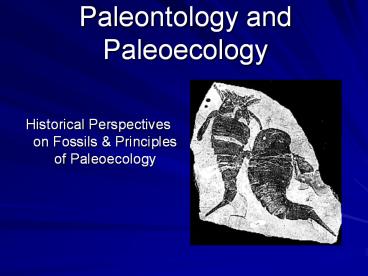Paleontology and Paleoecology - PowerPoint PPT Presentation
Title:
Paleontology and Paleoecology
Description:
Preferences/Lifestyles of Organisms Tell Us About Environmental Conditions ... Passive/semi-active. Filter feeding. Active Feeding. Swimming, crawling, ... – PowerPoint PPT presentation
Number of Views:1425
Avg rating:3.0/5.0
Title: Paleontology and Paleoecology
1
Paleontology and Paleoecology
- Historical Perspectives on Fossils Principles
of Paleoecology
2
Historical Perspectives on Fossils
- Shaped Stones
- Lightning scars, supernatural temptations, divine
jokes and mysterious vapors - Washed in during biblical flood
- Crawled into rock and died
- Fossil something dug up (Latin)
3
Leonardo da Vinci(1452-1519)
Leonardo sketched fossils and recognized them as
the remains of ancient life.
4
Niels Stenson(a.k.a. Nicholas Steno)(1638-1686)
- Observations on sediments
- Superposition
- Original horizontality
- Original lateral continuity
- tongue stones
5
Niels Stenson(a.k.a. Nicholas Steno)(1638-1686)
- Tongue stones looked like teeth because they
were teeth! - Fossils are remains of once living creatures
(revival of DaVincis interpretation).
6
Robert Hooke (1703)
- These remains have a fixed life span and
therefore can be used like Roman coins in
determining age relationships - First statement of fossil succession
- Concept revisited by William Smith in early
1800s - Smith used fossils to correlate and make the
first geologic map
7
Fossils
- Remains or traces of ancient life
- Bones, Teeth, Shells, Tracks, Trails
- Soft tissues rare
8
Utility of Fossils
- History of Life on Earth
- Evolution appearances of new species
- Extinction disappearances of species
- Framework for other events in Earths History
- Guide in exploring for fossil fuels
- Important clues to ancient environmental
conditions
9
Principles of Paleoecology
- Organisms adapt to their environments
- Fossils provide clues to organism lifestyle
- Analogy to living relatives
- Functional Morphology
- Association with other fossils similar
preferences - Type of substrate
10
Environmental Factors that Influence Distribution
of Organisms
- Salinity
- Oxygenation
- Temperature
- Light
- Nutrients
- Type
- Abundance
- Distribution
- Agitation/Currents
- Clarity/Cloudiness of Water
- Substrate preferences
- Grain Size firm/soft
- Composition
- Mobility/stability
11
Preferences/Lifestyles of Organisms Tell Us About
Environmental Conditions
- Sessile organisms rely on currents to bring food
- Motile organisms can search for food in water or
in/on sediment - Distribution of food related to
agitation/currents - Therefore, related to oxygenation also
12
Ways to Feed
- Producer Plants
- Primary Consumer Herbivore
- Secondary Consumer Carnivore
- Passive/semi-active
- Filter feeding
- Active Feeding
- Swimming, crawling, scavenging, preying































